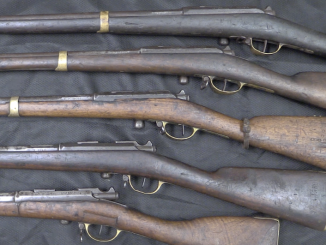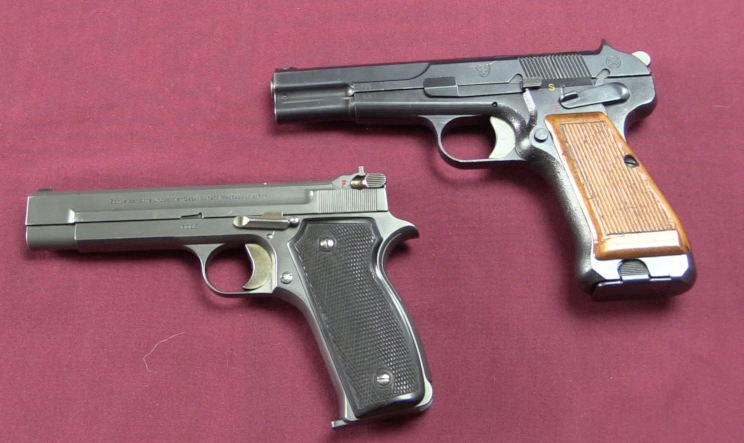Until now, there has really been nothing substantial and scholarly printed on the Chassepot needle-fire rifle in English – but now that has changed, thanks to Guy & Leonard A-R-West. Their just-released book on the system covers everything from the development (including several competing systems form the 1850s and 1860s), the mechanics, the ammunition, the production and markings, and the historical impact the rifle had in Europe.
Despite the French defeat in the Franco-Prussian War, the Chassepot was a stand-out piece of technology, offering substantially higher velocity and longer effective range than the Dreyse rifles used by the Prussian forces. It was such an impressive rifle that tens of thousands were reissued by German cavalry units, both in the original needlefire configuration and converted to 11mm Mauser metallic cartridges.
The authors cover the modification from the first production rifles to the standard later versions, and also the progressive improvements to the ammunition. Visually, this is done with a combination of photographs and hand drawings. The photographs are sometimes a bit small, and the drawings (which are very well done) do a good job of showing the specific details the authors are trying to highlight. The occasional firsthand commentary taken from soldiers on both sides of the 1870/71 battles also adds a very interesting flavor to the narrative.
The book is published in the UK, and runs 145 pages softcover (but in color). As of this writing, the price is £45.00 plus shipping, and it can be ordered directly from the publisher’s web site or through them on Amazon.uk.




Hi Ian, Thanks for reviewing this book. Copy ordered!
I had no idea this was out there and rifles of that period are my main area of interest. Guy and Leonard A-R West’s illustration work is of really high quality. I was very impressed by their work in Robert Wilsey’s book on the Italian Vetterli rifle that you’ve reviewed in the past. Looking forward to the rest of the series.
During the Franco-Prussian War, both sides made blunders of varying kinds. The Prussians did not anticipate the French using balloons for artillery spotting and (allegedly) VIP evacuation. Prussian soldiers also had a bit of a shock when encountering intact groups of fully functional Montigny volley guns for the first time (whenever nearby Prussian artillery units weren’t informed of potential French “secret weapons” in the area and therefore were not given the order to bombard the positions of the “secret weapons”) and found out that their rifles were not enough to counter the rapid-fire barrage. The French in turn bungled in that their commanding officers had insisted on doing their business the “old fashioned way” to the point that all units marched on foot to the war front from home base, even if they could have requisitioned trains for transportation to approach the front line and then disembark at the closest train station. Also, the French high command bragged about having secret weapons, a very bad idea if one’s opponents happen to think “secret weapons must be engaged by massed artillery at long range in order to reduce risk to our infantry.” Also both sides refused to officially use or compare weapons developed abroad, not that doing so was a good idea, but they did not see any potential gains from studying foreign weapons systems. You know how this usually ends.
“All guns used by the French Army must be developed in France and designed by Frenchmen!”
“All guns used in the Kaiser’s service must be German in everyway!”
Gatling: “Such fools never looked beyond their own noses and insisted on marching their men to their deaths!”
Did I mess up?
“even if they could have requisitioned trains for transportation to approach the front line and then disembark at the closest train station”
This is not so simple, organize everything to avoid conflicts (our train goes first! our is more important!…).
Even so, taking the time to schedule train rides for the troops certainly beats having them arrive at the battle front completely exhausted due to a long march.
“both sides refused to officially use or compare weapons developed abroad”
See ironclad: https://fr.wikipedia.org/wiki/Rochambeau_(1865)
which was used by French, produced in U.S.
The French later bought many items from the US to include Egyptian pattern Remington Rolling Blocks, and 50-70 Springfield rifles and carbines. I am not positive, but there were also Spencer Carbines that were purchased. I have heard of American arms with French and later Prussian proofs. Leon Gambetta escaped from Paris via Balloon.
They also bought every American revolver they could. Apart from some privately ownd guns the French Army had no revolvers in 1870. Although there were several revolver manufacturers already in France,they could not fulfill the sudden need of thousands of guns.
Every time the French were in fortified positions the Chassepots would take a heavy toll on the Prussian soldiers who were clearly outgunned in range.
EXCEPT if they had Bavarian Jaeger-formations with them! Those were armed with the Werder-rifle M1869 “Adaptiertes” (-> adapted to the Prussian caliber):
http://militarygunsofeurope.eu/listing/bavarian-werder-1869-infantry-rifle/
I’ve been looking for a Werder,,,
Chassepot unbarreled action cans still be found at french gun shows for 5 to 10 euroes Interesting to collect for their markings
Complete guns are about 800 euroes
Chassepots converted to gras are a bit more but those converted to 24 gauge shotguns are only about 80 euroes
I picked up a very rusted defence national remingtomn rolling block barreled action for 15 euroes
werders sell for about 1200 euroes but I may be low